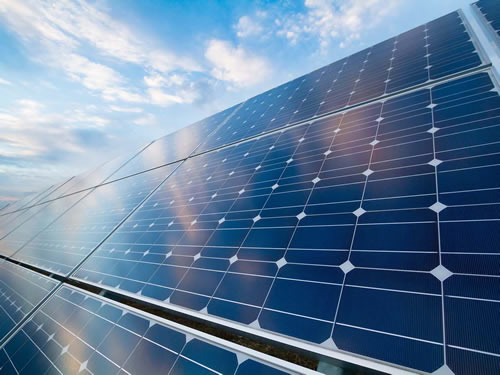Photovoltaic components are evolving from single-function power generation devices into multidimensional energy conversion platforms, with application scenarios extending far beyond traditional boundaries. Through material innovation and system integration, these semiconductor-based photoelectric conversion devices are constructing a three-dimensional energy capture network across building surfaces, mobile carriers, ecological spaces, and even near-Earth orbits, accelerating humanity’s transition toward a solar-powered civilization.
I. Traditional Energy Replacement Systems
Rooftop PV systems are reshaping urban energy supply models. Distributed generation units, connected via smart inverters and microgrids, form decentralized energy networks. Latest bifacial modules combined with tilt optimization algorithms boost power generation efficiency per unit area by 27%. Some commercial and industrial buildings already achieve complete energy self-sufficiency, with surplus electricity traded peer-to-peer via blockchain technology.
Large-scale ground-mounted power plants create new ecological value through system integration. Bifacial modules paired with intelligent tracking mounts enable photovoltaic arrays to serve dual purposes like windbreak stabilization and vegetation conservation. In agrivoltaic mode, precise control of module elevation and light transmittance creates microclimates ideal for high-value crops, increasing comprehensive land productivity by 5–8 times.
Floating PV systems unlock new dimensions of water resource utilization. Anti-PID encapsulation and corrosion-resistant designs ensure 25-year power warranties in aquatic environments. Covering reservoirs or lakes with photovoltaic panels reduces water evaporation by up to 70% while inhibiting algae growth, forming unique aquatic ecological regulation systems.
II. Functionally Integrated Innovations
Building-integrated photovoltaics (BIPV) transform components into functional building materials. Colorful PV facades with adjustable transparency meet architectural aesthetics while generating electricity. Seamless integration of photovoltaic tiles into roofing structures enables green retrofits of heritage buildings. Self-cleaning nanocoatings allow building surfaces to simultaneously generate power and purify air.
Mobile energy systems redefine vehicle power logic. Vehicle-integrated PV systems stabilize solar conversion efficiency above 23% via MPPT optimization algorithms. Flexible modules on electric vehicle surfaces significantly alleviate range anxiety, with experimental models achieving zero-charge commutes under sunny conditions.
Agricultural PV facilities enable controlled growth environments. Spectral-splitting technology allows specific light wavelengths to penetrate modules for photosynthesis while converting other bands into electricity. In vertical farming systems, PV glass greenhouses with smart light regulation boost crop yields by 40% while cutting energy consumption by 65%.
III. Cutting-Edge Technology Convergence
Space-based PV systems overcome atmospheric energy attenuation. Thin-film PV arrays in geostationary orbit, coupled with microwave wireless power transmission, enable 24/7 energy delivery. Modular orbital power stations achieve theoretical energy densities 6–8 times higher than terrestrial systems, providing sustained energy for deep-space exploration.
Flexible PV devices pioneer wearable electronics. Organic photovoltaic films thinner than 1mm maintain 90% initial efficiency after 100,000 bends. Combined with energy-storage fibers, smart clothing sustains mobile device operation under standard illumination, ushering in an era of personal energy autonomy.
PV-hydrogen coupling systems resolve spatiotemporal energy mismatches. Proton exchange membrane electrolyzers convert solar power to storable hydrogen at 75% efficiency. This green hydrogen serves as both an industrial feedstock and a fuel cell energy source, establishing cross-seasonal, cross-regional clean energy cycles.
From nanoscale photovoltaic coatings to megawatt ground arrays, from orbital power stations to deep-sea energy platforms, PV components are transcending physical limits and reshaping the topology of energy production and consumption. With perovskite tandem cells surpassing 32.5% theoretical efficiency and smart O&M systems achieving 98.7% availability, photovoltaic applications continue to expand. This photoelectric revolution is transforming every square meter of sunlight into programmable clean energy units, building the foundational energy matrix for sustainable human civilization.

 Jinko Solar 66HL4M-(V) 610W 615W 620W 630W 635W
Jinko Solar 66HL4M-(V) 610W 615W 620W 630W 635W Jinko Solar 78HL4-BDV Tiger Neo 625W-650W
Jinko Solar 78HL4-BDV Tiger Neo 625W-650W Jinko Solar 54HL4R-BDB Tiger Neo 425W-450W
Jinko Solar 54HL4R-BDB Tiger Neo 425W-450W  Jinko Solar 54HL4R-(V) Tiger Neo 435W-460W
Jinko Solar 54HL4R-(V) Tiger Neo 435W-460W LONGI HI-MOX6 LR7-72HTH 600W-620W
LONGI HI-MOX6 LR7-72HTH 600W-620W LONGI HI-MO7 LR5-72HGD 560W-590W
LONGI HI-MO7 LR5-72HGD 560W-590W LONGI HI-MO7 LR5-72HGD 585W-620W
LONGI HI-MO7 LR5-72HGD 585W-620W Ja Solar JAM72D30/LB 580W 575W 570W 565W Double Glass Bifacial Solar Module Panel
Ja Solar JAM72D30/LB 580W 575W 570W 565W Double Glass Bifacial Solar Module Panel Ja Solar JAM72D30-555/LB 555W DEEPBLUE3.0 Solar Module Panel
Ja Solar JAM72D30-555/LB 555W DEEPBLUE3.0 Solar Module Panel Ja Solar JAM72D30-560/LB MBB Bifacial Mono PERC 560W Double Glass Solar Module
Ja Solar JAM72D30-560/LB MBB Bifacial Mono PERC 560W Double Glass Solar Module Trina Solar Tsm-De09.05 Vertex S 380W-400W
Trina Solar Tsm-De09.05 Vertex S 380W-400W Trina Solar Tsm-DE09C.07 Vertex S 380W-405W
Trina Solar Tsm-DE09C.07 Vertex S 380W-405W Trina Solar Tsm-DE09C.05 Vertex S 380W-405W
Trina Solar Tsm-DE09C.05 Vertex S 380W-405W Trina Solar Tsm-NEG09RC.05 400W-430W
Trina Solar Tsm-NEG09RC.05 400W-430W Canadian Solar 520W-550W Bifacial Mono Solar Panel
Canadian Solar 520W-550W Bifacial Mono Solar Panel Canadian Solar 695W Pallet of TOPcon Solar Panels
Canadian Solar 695W Pallet of TOPcon Solar Panels Canadian Solar 605W N-type Bifacial TOPCon Solar Panels
Canadian Solar 605W N-type Bifacial TOPCon Solar Panels Canadian Solar 450W 108 Cells TOPCon BoB Solar Panel
Canadian Solar 450W 108 Cells TOPCon BoB Solar Panel


